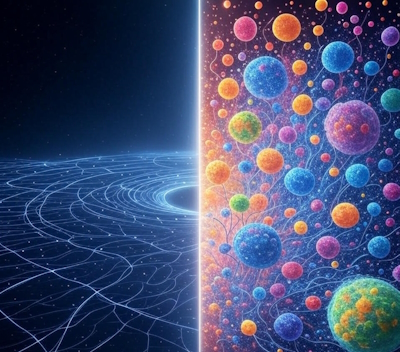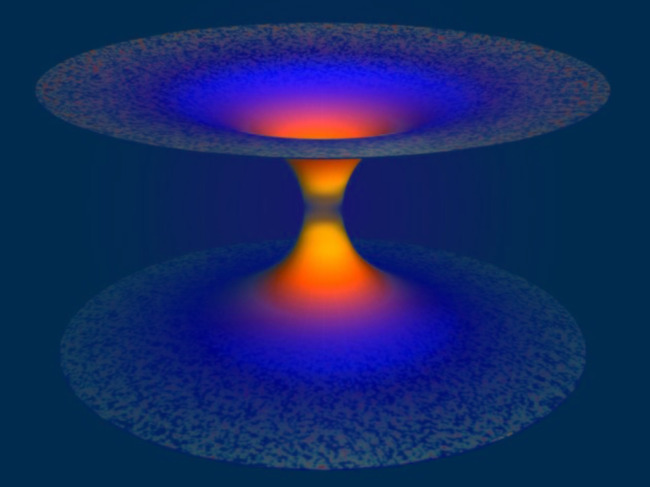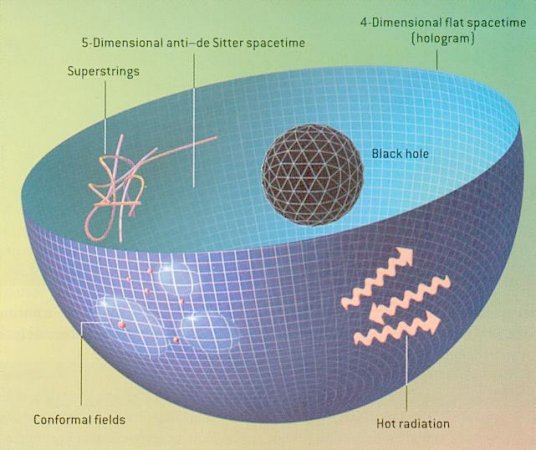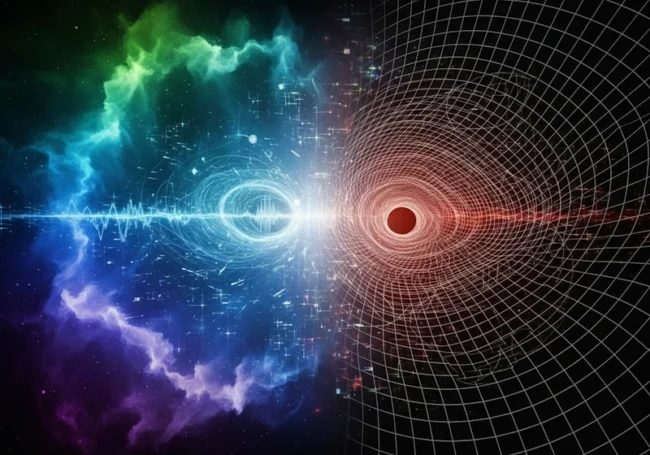Let’s imagine this: you’re standing at the edge of a black hole, watching spacetime itself twist into impossible geometries while quantum particles pop in and out of existence around you. This isn’t science fiction—it’s the bizarre realm where quantum mechanics meets general relativity, and where physicists are desperately trying to make sense of reality’s deepest layers.
We call this quest quantum gravity, and it might just be the most important unsolved puzzle in all of physics.
Classical and quantum gravity: what is the difference?
For over a century, we’ve lived with an uncomfortable truth: our two most successful theories simply refuse to play nice together. General relativity paints gravity as the curvature of spacetime—elegant, smooth, predictable on cosmic scales. Quantum mechanics describes everything else through probabilities, uncertainties, and the strange dance of particles at the smallest scales.

Both theories work brilliantly in their own domains. GPS satellites wouldn’t function without relativistic corrections, and your smartphone exists thanks to quantum effects in semiconductors. But ask what happens when you need both—say, inside a black hole or during the first moments after the Big Bang—and physics throws up its hands in surrender.
The math literally breaks down. Infinities appear where they shouldn’t. Causality gets murky. It’s as if nature speaks two completely different languages depending on the scale you’re examining.
The granular Universe: what is loop quantum gravity?
One of the most mind-bending possibilities emerging from quantum gravity research is that spacetime itself might be granular—made of discrete chunks rather than being smoothly continuous like we’ve always assumed.

Loop quantum gravity, one of the leading approaches, suggests that space comes in tiny, indivisible units about 10^-35 meters across (the Planck length). At this scale, the smooth fabric of Einstein’s spacetime gives way to something more like a cosmic foam, bubbling and fluctuating in ways that would make even the most seasoned physicist dizzy.
Carlo Rovelli, one of the theory’s architects, describes it poetically: space isn’t a container that holds things, but rather emerges from the quantum relationships between objects themselves. It’s a bit like how temperature emerges from the collective behavior of molecules—there’s no such thing as the temperature of a single atom.
Strings, loops, and other wild ideas
The landscape of quantum gravity approaches reads like a physics fever dream. String theory proposes that fundamental particles aren’t points but tiny vibrating strings in eleven dimensions. Loop quantum gravity focuses on quantizing spacetime itself. Causal set theory suggests spacetime is built from discrete points connected by cause-and-effect relationships.

Then there are the real wild cards: emergent gravity theories that treat gravity not as fundamental but as something that emerges from more basic quantum information processes, much like thermodynamics emerges from statistical mechanics. Some researchers even propose that gravity might be an illusion—a side effect of how quantum information gets entangled across space.
Each approach brings its own insights and problems. String theory is mathematically gorgeous but requires dimensions we can’t see and predicts phenomena we can’t test. Loop quantum gravity avoids some infinities but struggles to recover classical gravity at large scales. Emergent approaches offer fresh perspectives but often lack detailed mathematical frameworks.
The information paradox
Perhaps nowhere is the clash between quantum mechanics and gravity more dramatic than in black holes. When Stephen Hawking showed that black holes should evaporate by emitting radiation, he accidentally created one of physics’ most stubborn paradoxes.
Here’s the problem: quantum mechanics insists that information can never be truly destroyed. But if a black hole evaporates completely through Hawking radiation, where does the information about everything that fell in go? Does it vanish, violating quantum mechanics? Or does it somehow escape in the radiation, violating our understanding of black holes?
Recent work suggests the answer might involve “quantum error correction”—the same principles that protect quantum computers from errors might also protect information falling into black holes. The holographic principle proposes that all the information in a black hole’s interior is actually encoded on its surface, like a cosmic hologram.
Time gets weird
In the quantum gravity realm, even time becomes negotiable. Some theories suggest that time itself might be an emergent property rather than fundamental. At the deepest level, there might be no time at all—just quantum correlations that create the illusion of temporal flow.
This isn’t as crazy as it sounds. We already know that time is relative, flowing differently for observers in different gravitational fields.
But quantum gravity pushes this further: perhaps the very notion of “before” and “after” breaks down at the Planck scale, replaced by something more subtle involving quantum superpositions of different spacetime geometries.
The experimental challenge
Here’s the frustrating part: quantum gravity effects are typically so small that they’re nearly impossible to observe directly. The energy scales where these phenomena become important are trillions of times higher than anything we can produce in particle accelerators.
But physicists are nothing if not resourceful. They’re looking for subtle signatures in gravitational waves, studying the cosmic microwave background for hints of quantum spacetime, and using black hole mergers as natural laboratories for extreme physics. Some researchers even hope that quantum computers might eventually simulate quantum gravity effects.
The recent detection of gravitational waves has already provided new ways to test general relativity in extreme conditions. Future space-based detectors might be sensitive enough to spot quantum corrections to Einstein’s predictions.
What’s at stake
Why should anyone care about resolving the quantum gravity puzzle? Beyond intellectual satisfaction, the answer could revolutionize our understanding of reality itself.
A working theory of quantum gravity might finally explain what happened in the first moments of the Big Bang, resolve the mystery of dark energy, or reveal whether our universe is part of a vast multiverse. It could lead to technologies we can barely imagine—perhaps ways to manipulate spacetime directly or harness quantum effects on macroscopic scales.
More fundamentally, it might answer some of philosophy’s deepest questions: Is space real or emergent? Does time flow or is it an illusion? What is the nature of existence at its most basic level?
The path forward
We’re still far from a complete theory of quantum gravity, but the journey has already transformed our understanding of physics. The quest has forced us to question assumptions about space, time, and reality that seemed unshakeable just decades ago.
Perhaps most importantly, it’s taught us humility. The universe at its deepest level appears to be far stranger than our everyday experience suggests. Particles exist in multiple places simultaneously, information becomes physically meaningful, and spacetime itself might be woven from pure quantum relationships.
The next breakthrough could come from any direction: a flash of mathematical insight, an unexpected experimental result, or perhaps a completely new approach that no one has thought of yet. What’s certain is that when we finally crack the quantum gravity code, our picture of reality will never be the same.
Until then, we’re left with one of the most beautiful puzzles in all of science—a reminder that despite all our technological prowess, the universe still holds secrets that would humble even Einstein himself.
Sources
- Rovelli, C. (2008) ‘Loop Quantum Gravity’, Living Reviews in Relativity, 11(5). Available at: https://link.springer.com/article/10.12942/lrr-2008-5 (Accessed: 15 August 2025).
- Ashtekar, A. & Lewandowski, J. (2004) ‘Background independent quantum gravity: A status report’, Classical and Quantum Gravity, 21(15), pp. R53–R152.
- Harlow, D. (2016) ‘Jerusalem Lectures on Black Holes and Quantum Information’, Reviews of Modern Physics, 88(1), 015002.
- Bekenstein, J.D. (2003) ‘Information in the Holographic Universe’, Scientific American, 289(2), pp. 58–65.
- Hawking, S.W. (1976) ‘Breakdown of Predictability in Gravitational Collapse’, Physical Review D, 14(10), pp. 2460–2473.
- Maldacena, J. (1999) ‘The Large N Limit of Superconformal Field Theories and Supergravity’, International Journal of Theoretical Physics, 38, pp. 1113–1133.
- Polchinski, J. (1998) ‘String Theory’ Vols 1 and 2, Cambridge: Cambridge University Press.
- Smolin, L. (2001) ‘Three Roads to Quantum Gravity’, New York: Basic Books.
- Susskind, L. (2008) ‘The Black Hole War: My Battle with Stephen Hawking to Make the World Safe for Quantum Mechanics’, New York: Little, Brown and Company.
- Seiberg, N. (2020) ‘Emergent Spacetime’, Annual Review of Nuclear and Particle Science, 70, pp. 263–284.
- Sorkin, R.D. (2005) ‘Causal Sets: Discrete Gravity’, in Gibbons, G.W., Shellard, E.P.S. & Rankin, S.J. (eds.) The Future of Theoretical Physics and Cosmology. Cambridge: Cambridge University Press, pp. 603–617.
- Wald, R.M. (2001) ‘The Thermodynamics of Black Holes’, Living Reviews in Relativity, 4(6).

Leave a Reply